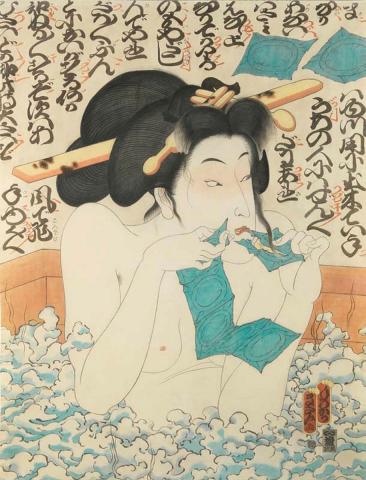ESSAY: Teraoka and contemporary ukiyo-e
By Reuben Keehan
‘We Can Make Another Future’ September 2014
During the Edo period (1615–1868), ukiyo-e printmakers creatively captured life for a broad, curious and eager audience. Indebted to these artists, Masami Teraoka borrows from ukiyo-e traditions to construct a contemporary visual language. Through lavish styles and rich imagery, Teraoka exposes the issues and experiences important to him, referencing consumerism, eroticism and politics from the perspective of a Japanese artist living in the United States since 1964.
31 Flavors Invading Japan and McDonald’s Hamburgers Invading Japan, both created in the 1970s, were opportunities for Teraoka to comment on the Americanisation of Japan following World War Two. Baskin-Robbins was one of the first fast‑food chains to ‘invade’ Japan, and Teraoka was inspired to create a design for each of its 31 ice-cream flavours, featuring women resembling nineteenth-century courtesans awkwardly interacting with the unfamiliar products.1 Ukiyo-e artists were creative in subverting censorship for social commentary, and Teraoka similarly includes discreet motifs to apply wit and humour to his works.2
Teraoka was deeply affected when a friend’s baby contracted HIV from a blood transfusion in 1986, and he felt compelled to draw attention to the issue, in particular to the American government’s failure to address it adequately. Therefore, his AIDS Series represents a critical moment in Teraoka’s practice. These works surpass the free and self-indulgent sexuality he previously depicted, and instead address the personal betrayal he felt resulting in more serious examinations of Euro‑American politics and their hegemonic power.3 AIDS Series/Geisha in Bath 1988 features a bare-breasted, Kunisada‑esque4 geisha tearing condom wrappers with her teeth as she bathes in water, rendered in a style influenced by the well-known works of Katsushika Hokusai. The Japanese text translates as:
It won’t open, no scissors, and I don’t want to borrow from next door. Well, I’ll open it with my teeth . . . oooh, what’s that smell — spermicide? Slippery too. This must be extra-large export size. It sure won’t fit my boyfriend!5
Teraoka moved from Los Angeles to Hawaii in 1980 and the Pacific Ocean inspired numerous recreations of ukiyo-e works, with their sea monsters, maritime battles, fishing vessels and pleasure boats. Teraoka also extended his AIDS Series to encompass parodied scenes of sex and mythical fantasy on the sea. Of these images, Hokusai’s Dream of a fisherman’s wife from the 1814 erotic book Kinoe no Komatsu (Young Pine Shoots), in which a naked woman is entangled in an amatory yet horrific encounter with two octopuses, is a key inspiration. Teraoka appropriated this image for his mid-1980s ‘Wave’ series and his 1992 ‘New Wave’ series, in which a blonde-haired tourist, Sarah, appears in place of the ukiyo-e figures. In 2001, Teraoka revisited the subject in a striking image created in a handcarved, 29-colour traditional woodblock. On the crest of breaking waves, a writhing octopus appears to pleasure Sarah, who holds a condom in her hand and is surrounded by crumpled tissues, a symbol of lovemaking often used by ukiyo-e artists.6 Calligraphic text narrates the ravishing scene, just as Hokusai’s print appeared as an illustration under the script lines of a storybook. The scene captures the theatrical drama for which ukiyo-e artists were known, along with their underlying preoccupation with exploring male and female sexuality. Infused with innuendo and anxiety about globalisation, this image, as with all of Masami Teraoka’s works, borrows from a celebrated historic style to satirise and criticise contemporary concerns.
Endnotes
- Gary Hickey, ‘Cross-cultural traveller: The floating world of Masami Teraoka’, in Lynne Seear and Suhanya Raffel (eds), The 5th Asia–Pacific Triennial of Contemporary Art [exhibition catalogue], Queensland Art Gallery, Brisbane, 2006, p.226. Both 31 Flavors Invading Japan/French Vanilla 1978 and McDonald’s Hamburgers Invading Japan/Chochin-me 1982 are in the Collection of the Queensland Art Gallery.
- Teraoka embeds a variety of sexual references and comments in cartouches and stamps, which were often used to identify artists and publishers, as well as characters and series titles, in ukiyo-e works.
- Catharine Clark, Ascending Chaos: The Art of Masami Teraoka 1966–2006, Chronicle Books, San Francisco, 2006, p.8.
- Utagawa Kunisada (1786–1865) was one of the most popular and prolific ukiyo-e artists of the nineteenth century in Japan.
- Alison Bing, ‘Masami-za: The narrative art theater of Masami Teraoka’, in Clark, p.115.
- John Stevenson, ‘The floating world of Masami Teraoka’, in Masami Teraoka: From Tradition to Technology, The Floating World Comes of Age, University of Washington Press, Seattle, Wash., 1997, p.11.

